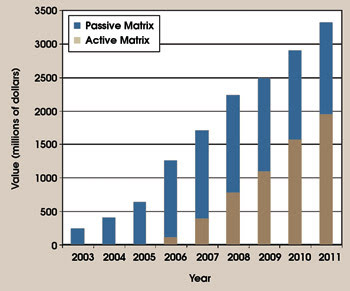Anne L. Fischer, Senior Editor
With organic LEDs (OLEDs) used primarily as replacements for LCDs, the market faces several challenges, says the most recent edition of “Organic Light-Emitting Diode Displays,” a semiannual report released by iSuppli Corp. of El Segundo, Calif.
Technology and manufacturing challenges are being addressed, centering mainly on device structure and materials improvement. The document says that performance improvements have resulted from new methods such as top emission, the addition of blocking layers and the inclusion of color filters in manufacturing.

The worldwide OLED display shipment value projection shows a steady increase in active-matrix versus passive-matrix devices from 2003 to 2011. Courtesy of iSuppli Corp.
Active-matrix displays are receiving much more attention than passive-matrix ones are, and the report indicates that few companies are investing in new passive-matrix production lines. The major driver in OLED technology continues to be lifetime, which currently is between 5000 and 15,000 hours (time to half brightness).
Passive-matrix products, however, are being released. For example, Samsung Electronics, LG Electronics and Fujitsu are using a passive display in several models of mobile phones. And passive-matrix OLEDs are widely used in MP3 players sold in Asia.
In fact, although interest has swung in favor of active-matrix displays, their manufacture is proceeding slowly because of the high costs involved. Compatibility with the production of low-temperature polycrystalline silicon active-matrix LEDs, however, may help some companies to ramp up manufacturing.
The report includes forecasts to 2011, an analysis of trends and strategies for success for OLED manufacturers. Overall shipments are expected to grow from about $250 million in 2003 (passive matrix) to $3.3 billion in 2011 (both active and passive).
As for products, the publication names the MP3 player as the new “entry” application for simple OLEDs, replacing the mobile phone subdisplay. In 2005, 53 percent of flash-based MP3 players used OLEDs. However, the mobile phone will remain the most important application for OLEDs in this decade, with active-matrix devices reaching that market in early- to mid-2006. The report forecasts that 78 percent of market value will come from mobile phones in 2011, with active-matrix displays leading the way.
Be on the lookout for tiny OLED TVs reaching the market in 2007. The initial units will have a diagonal dimension of less than 5 in. and likely will be small-molecule OLED panels. Larger versions will come to market beginning in 2008, although prices will remain high while shipment levels remain modest. Other products that will come to use OLEDs are handheld video cameras, portable DVD players and automotive displays.
OLEDs for solid-state lighting are primarily in the research stage, but industrial and academic projects are under way worldwide. For example, a $25 million project called Organic LEDS for Lighting Applications involves 24 entities in Europe. Led by Philips Electronics in the Netherlands, the four-year program is working to develop materials with a lifetime of 10,000 hours and an efficiency of 50 lm/W. Similar projects are ongoing in Japan and the US. The report indicates that it will take 15 to 20 years for the technology to establish a strong market in the lighting industry.
Among its recommendations is that manufacturers cease to invest in new passive-matrix production lines and instead look for particular active-matrix applications with at least a single, large, stable customer. Overall, the report states that this recent entry into the display market is forging its own way while working within the bounds established by the venerable LCD.
The report, released in October, sells for $6950 (for two semiannual reports). For more information, go to www.isuppli.com.